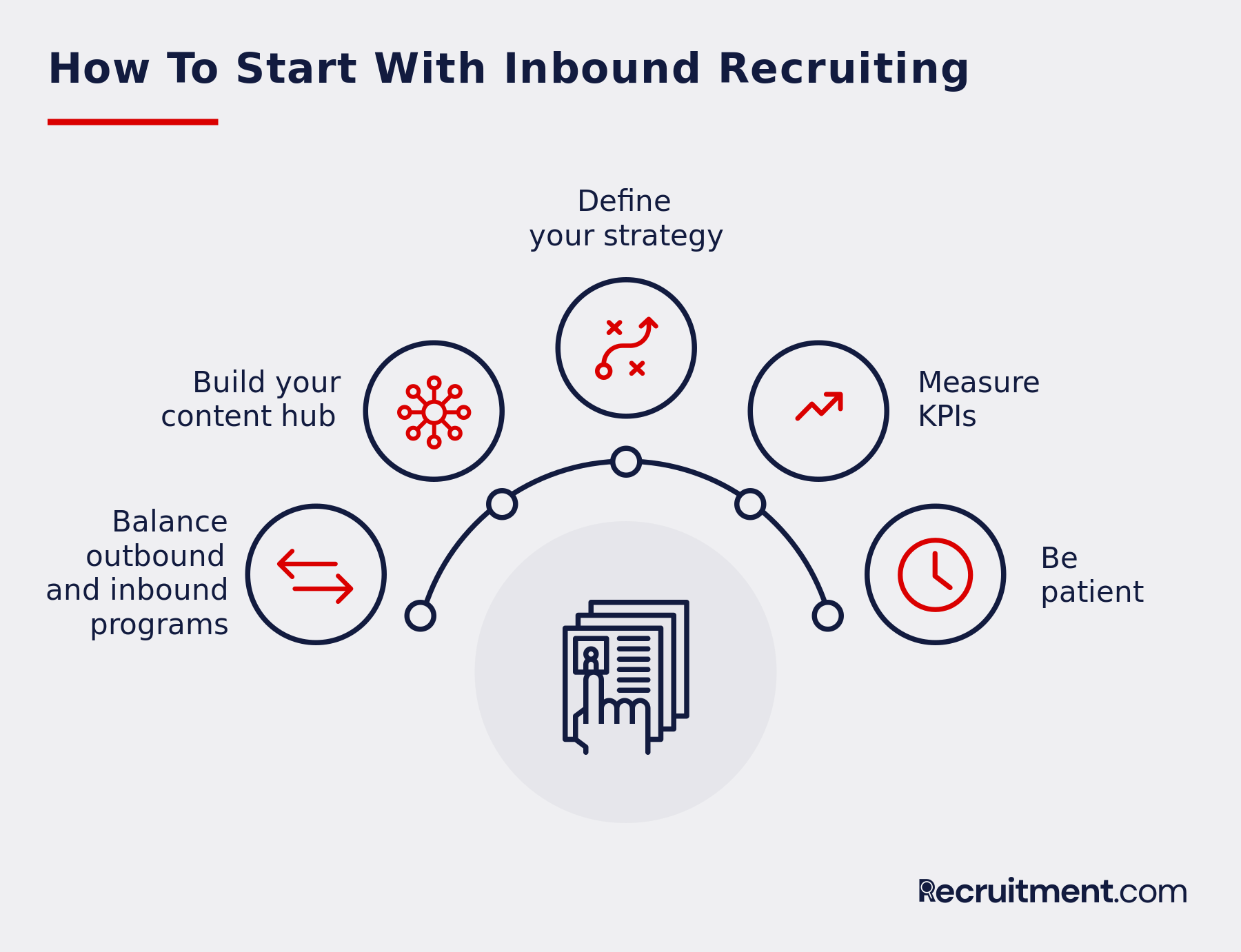Your Inbound Recruiting Strategy Requires Focus

Ritika Puri has written for LinkedIn, Twitter, PNC, Forbes, Entrepreneur, and more. She also advises on HR and communications strategies.
Recruiters need to think more like marketers to attract and find talent through an inbound strategy.
As a recruiter, you have a limited number of hours in your day. But you also wear many hats and are in perpetual context-switching mode. The cognitive overhead of these frequent mental shifts add up: according to one psychologist, multitasking can cause businesses to lose up to 40% of their productivity:
“The research shows that people can attend to only one cognitive task at a time,” writes Susan Weinschenk, Ph.D. for Psychology Today. “ You can only be thinking about one thing at a time. You can only be conducting one mental activity at a time. So you can be talking or you can be reading. You can be reading or you can be typing. You can be listening or you can be reading. One thing at a time. We are pretty good at switching back and forth quickly, so we THINK we are actually multi-tasking, but in reality we are not.”
One way to minimize context-switching as an individual—and as a team of recruiters—is an inbound recruiting strategy.
Through content like blog posts, social media, webinars, or videos, you can create a consistent stream of candidates applying for roles. As a result, you reduce the time you spend sourcing candidates and spend less time context-switching in your job.
Inbound recruiting comes from the inbound marketing methodology, which HubSpot pioneered in the early 2000s. HubSpot has systematized the process of creating a pull mechanism of people to businesses as potential customers. That model is equally applicable to recruiting, in which companies need to be magnets for candidates.
Here’s how HubSpot explains the concept:
Inbound recruiting creates a remarkable candidate experience through employer branding content and marketing strategies that help companies build relationships with top talent. By taking an inbound marketing approach to recruiting, companies can connect with passive and active job seekers, engage with their network, and delight candidates throughout the application process.
Inbound recruiting can be as simple as writing blog posts and publishing them, regularly.
It could be as creative as creating informative videos that you host on your website, publish on YouTube, or share through an email newsletter.
“Recruiters need to think more like marketers to create an engaging, helpful candidate experience,” says HubSpot.
That means as a recruiter, you’re a tour guide of your company’s story, reflected through your employer brand. Here’s a framework that any company, of any size, can use to build an inbound recruiting strategy:
An Inbound Recruitment Strategy
Content and creative are the heart of any employer branding program. Any company has the capacity to create engaging content by sharing the knowledge they’re amassing—and providing a look behind-the-scenes of what’s happening with your company.

1. Know what a balanced outbound and inbound program looks like
With inbound recruiting, candidates find their way to your company. With outbound recruiting, recruiters actively search for candidates.
Both strategies are necessary for a healthy recruiting program. For instance, if you’re hiring an engineering leader with a niche set of skills, you’ll likely need to venture out and find that individual. If you’re consistently hiring entry-level engineers or sales professionals, you’ll find value in an inbound program in which less experienced candidates find your company—and actively apply to roles.
The extent to which you use outbound and inbound recruiting depends on the candidate volume you need to generate, for your roles. As the TalentLyft blog elaborates, “inbound and outbound recruiting programs focus on different stages of the candidate journey.”
To put it simply: Outbound recruiting helps organizations meet short-term staffing goals. Inbound recruiting, on the other hand, is a process for long-term relationship building with candidates.
With inbound recruiting, your goals extend beyond the need to staff an open position.
Your goals include:
- Encouraging candidates to consider their next career move
- Creating visibility around your company, so audiences are actively monitoring open roles
- Maintaining a consistent stream of updates and communication of people who are interested in your company
- Establishing your company as a top employer for the personas you’re striving to reach
Inbound and outbound programs build upon each other.
By creating content on a consistent basis, your company will become more memorable. By becoming more memorable, you build credibility—which makes recruiting activity easier.
When you reach out to potential candidates, you create more visibility around your inbound marketing efforts. In this way, outreach generates a feedback loop into valuable return visits to your brand and website.

2. Build your content hub
The biggest value proposition of inbound recruiting is that efforts are scalable and predictable. Over time, as you build up your content program, you’ll be able to build forecasting models around your transaction cycles—in this case, the path that candidates take to submitting applications for roles.
The process begins with the content that you share on your careers site. If you’re a large company, you likely already have one in place. Consider adding more content, including a mix of photos, videos, case studies, and company stories. You can even share recordings of events within your company.
A blog is something that any company of any size and build.
The key to being successful with a blog is to maintain a consistent publication schedule, write about helpful topics, and create incentives for audiences to continue engaging with your content. With these incentives, you will encourage return visits to your website, to help prospective candidates stay in touch with your recruiting team.
For inspiration, take a look at Intuit, which publishes videos tailored to recent grads. These feature stories of specific individuals who have grown within the company, along with offering a tour of what it’s like to work at the company, behind the scenes.
As your company grows, your recruiting team will likely gain more budget to hire. With more resources, you can develop multimedia content in the form of videos, training materials, and webinars.
Think of content and creative as the “command center” of your inbound recruiting efforts. Your command center can be as simple as a blog or as sophisticated as a multimedia experience and interactive microsite.
Start simple and build up. Your blog could be as simple as you and your teammates publishing articles on LinkedIn—and distributing them through twitter. You can even send updates manually, every time you publish a new post.
3. Define your talent acquisition strategy
The biggest benefit of inbound recruiting is that you build a direct relationships with potential hires all over the world.
These same potential hires can be referral sources to your business. When it comes to traffic acquisition, the key is to catch audiences in the moment. That means tapping into the places where potential candidates are already online.
Here are some ideas to help you build a steady stream of eyeballs to your content:
- Create a link to your content and career portal on your job listings. Mention that you run a blog or newsletter to which candidates can subscribe.
- Consider running a Facebook campaign based on the exact criteria of the people you’re looking to hire.
- Include a link to your content in your email signature.
- Sync up with your communications or marketing team.
- Encourage teammates within your company to share the content that you’re creating, on LinkedIn, where people are likely to be searching for jobs.
- Team up with influencers, within or outside of your company, who are committed to the mission of helping others find meaningful careers.
- If your teammates speak at conferences or get interviewed for podcasts, ask them if they would be willing to include a link to job opportunities within their speaker decks.
By sending people to your company and career portal, you’ll create an echo and amplification effect with your paid marketing spend. You can use the channels that are already core to your recruiting efforts, to build a direct line of communication between your company and passive candidates—people who are learning about your company but may not be interested in making an immediate job switch.
The key to success traffic acquisition is the same in recruiting as it is in marketing, according to a recent article from Mark W. Shaefer, a marketing consultant, in the Harvard Business Review:
“Talking about the culture at work, commenting about the pride they have in an organization, or posting photos from a company picnic … well, that’s easy to do. We should give employees the training and tools to do their very best job when creating content about the employment culture of the company.”
In other words, tap into existing conversations that are already taking place. That means joining forces with—and learning alongside—your marketing team.

4. Create a strategy for measuring KPIs
Carefully chosen HR metrics help entities run more efficiently.
To know what’s working—and what isn’t—it’s important to keep track of how your content translates back into performance for your recruiting team. For instance, you may want to quantify whether audiences find your creative valuable. In this case, you may decide to run a survey among applicants or a brand lift study to see how people are talking about your company on social networks.
You’ll also want to see how your core recruiting metrics evolve over time. Do you see faster times to sourcing, hiring, and placing candidates? Are hiring managers reporting back that you’re finding higher-quality candidates.
Even more simply, who’s coming back to your website?
By understanding your KPIs, you can craft a more efficient recruiting process for your business. You can tailor your content program to the needs of the people you’re seeking on board. Lou Adler, recruiting strategist elaborates on this idea on LinkedIn:
At its core, the Inbound process is designed to fill jobs as efficiently as possible with people who are unemployed, underemployed, or dissatisfied with their work and who are perfectly qualified.
CEO, Performance-based Hiring Learning Systems
Conclusion: Be Patient With Your Inbound Recruiting Strategy
An inbound recruiting strategy is a direct reflection of your company’s culture. As a recruiter, your goal is to tell a true and authentic story about what’s happening within your organization, behind the scenes.
Inbound recruiting is a practice that requires dedication and focus. For that reason, you need to prioritize the long-term. Yes, you may see short-term gains along the way, for instance, if you write a blog post that results in 5 people getting hired. But the shelf life of that blog post is more important than what’s happening
As with inbound marketing, inbound recruiting aligns short-term KPIs with long-term outcomes. Learn, strategize, and adapt. Commit to a simple process that you can scale up over time. Remember that human connections are the heart of business, and inbound recruiting helps you build those relationships at scale. From 1:1, you go from one-to-many. With a one-to-many approach, you’ll meet candidates who you never knew existed, contributing to a more diverse and empowered workforce.
- What’s your inbound recruiting process?
- What types of candidates have you found with inbound recruiting?
- Who is doing inbound recruiting well?

Ritika Puri has written for LinkedIn, Twitter, PNC, Forbes, Entrepreneur, and more. She also advises on HR and communications strategies.






